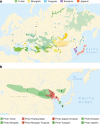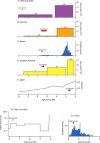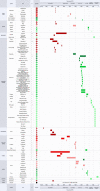Triangulation supports agricultural spread of the Transeurasian languages
- PMID: 34759322
- PMCID: PMC8612925
- DOI: 10.1038/s41586-021-04108-8
Triangulation supports agricultural spread of the Transeurasian languages
Abstract
The origin and early dispersal of speakers of Transeurasian languages-that is, Japanese, Korean, Tungusic, Mongolic and Turkic-is among the most disputed issues of Eurasian population history1-3. A key problem is the relationship between linguistic dispersals, agricultural expansions and population movements4,5. Here we address this question by 'triangulating' genetics, archaeology and linguistics in a unified perspective. We report wide-ranging datasets from these disciplines, including a comprehensive Transeurasian agropastoral and basic vocabulary; an archaeological database of 255 Neolithic-Bronze Age sites from Northeast Asia; and a collection of ancient genomes from Korea, the Ryukyu islands and early cereal farmers in Japan, complementing previously published genomes from East Asia. Challenging the traditional 'pastoralist hypothesis'6-8, we show that the common ancestry and primary dispersals of Transeurasian languages can be traced back to the first farmers moving across Northeast Asia from the Early Neolithic onwards, but that this shared heritage has been masked by extensive cultural interaction since the Bronze Age. As well as marking considerable progress in the three individual disciplines, by combining their converging evidence we show that the early spread of Transeurasian speakers was driven by agriculture.
© 2021. The Author(s).
Conflict of interest statement
The authors declare no competing interests.
Figures














Comment in
-
Tracking the origin of Transeurasian languages.Nature. 2021 Nov;599(7886):557-558. doi: 10.1038/d41586-021-03037-w. Nature. 2021. PMID: 34759333 No abstract available.
Similar articles
-
Tracing population movements in ancient East Asia through the linguistics and archaeology of textile production.Evol Hum Sci. 2020 Feb 14;2:e5. doi: 10.1017/ehs.2020.4. eCollection 2020. Evol Hum Sci. 2020. PMID: 37588355 Free PMC article. Review.
-
About millets and beans, words and genes.Evol Hum Sci. 2020 Jun 15;2:e33. doi: 10.1017/ehs.2020.33. eCollection 2020. Evol Hum Sci. 2020. PMID: 37588388 Free PMC article.
-
Genomic insights into the formation of human populations in East Asia.Nature. 2021 Mar;591(7850):413-419. doi: 10.1038/s41586-021-03336-2. Epub 2021 Feb 22. Nature. 2021. PMID: 33618348 Free PMC article.
-
Bioarchaeological perspective on the expansion of Transeurasian languages in Neolithic Amur River basin.Evol Hum Sci. 2020 May 14;2:e15. doi: 10.1017/ehs.2020.16. eCollection 2020. Evol Hum Sci. 2020. PMID: 37588356 Free PMC article.
-
Farmers and their languages: the first expansions.Science. 2003 Apr 25;300(5619):597-603. doi: 10.1126/science.1078208. Science. 2003. PMID: 12714734 Review.
Cited by
-
Genetic legacy of ancient hunter-gatherer Jomon in Japanese populations.Nat Commun. 2024 Nov 12;15(1):9780. doi: 10.1038/s41467-024-54052-0. Nat Commun. 2024. PMID: 39532881 Free PMC article.
-
Genetic analysis of a Yayoi individual from the Doigahama site provides insights into the origins of immigrants to the Japanese Archipelago.J Hum Genet. 2024 Oct 15. doi: 10.1038/s10038-024-01295-w. Online ahead of print. J Hum Genet. 2024. PMID: 39402381
-
Improving data archiving practices in ancient genomics.Sci Data. 2024 Jul 10;11(1):754. doi: 10.1038/s41597-024-03563-y. Sci Data. 2024. PMID: 38987254 Free PMC article.
-
Multiple Human Population Movements and Cultural Dispersal Events Shaped the Landscape of Chinese Paternal Heritage.Mol Biol Evol. 2024 Jul 3;41(7):msae122. doi: 10.1093/molbev/msae122. Mol Biol Evol. 2024. PMID: 38885310 Free PMC article.
-
Genomic imputation of ancient Asian populations contrasts local adaptation in pre- and post-agricultural Japan.iScience. 2024 May 21;27(6):110050. doi: 10.1016/j.isci.2024.110050. eCollection 2024 Jun 21. iScience. 2024. PMID: 38883821 Free PMC article.
References
-
- Starostin, S., Dybo, A. & Mudrak, O. Etymological Dictionary of the Altaic Languages Vol. I– III (Brill, 2003).
-
- Blažek, V. Altaic Languages. History of Research, Survey, Classification and a Sketch of Comparative Grammar (Masaryk Univ. Press, 2019).
-
- Robbeets, M. in The Oxford Guide to the Transeurasian Languages (eds Robbeets, M. & Savelyev, A.) 772–783 (Oxford Univ. Press, 2020).
-
- Mallory J, Dybo A, Balanovsky O. The impact of genetics research on archaeology and linguistics in Eurasia. Russ. J. Genet. 2019;55:1472–1487.
-
- Bellwood, P. & Renfrew, C. (eds) Examining the Farming/Language Dispersal Hypothesis (McDonald Institute for Archaeological Research, 2002).
Publication types
MeSH terms
LinkOut - more resources
Full Text Sources
Research Materials


